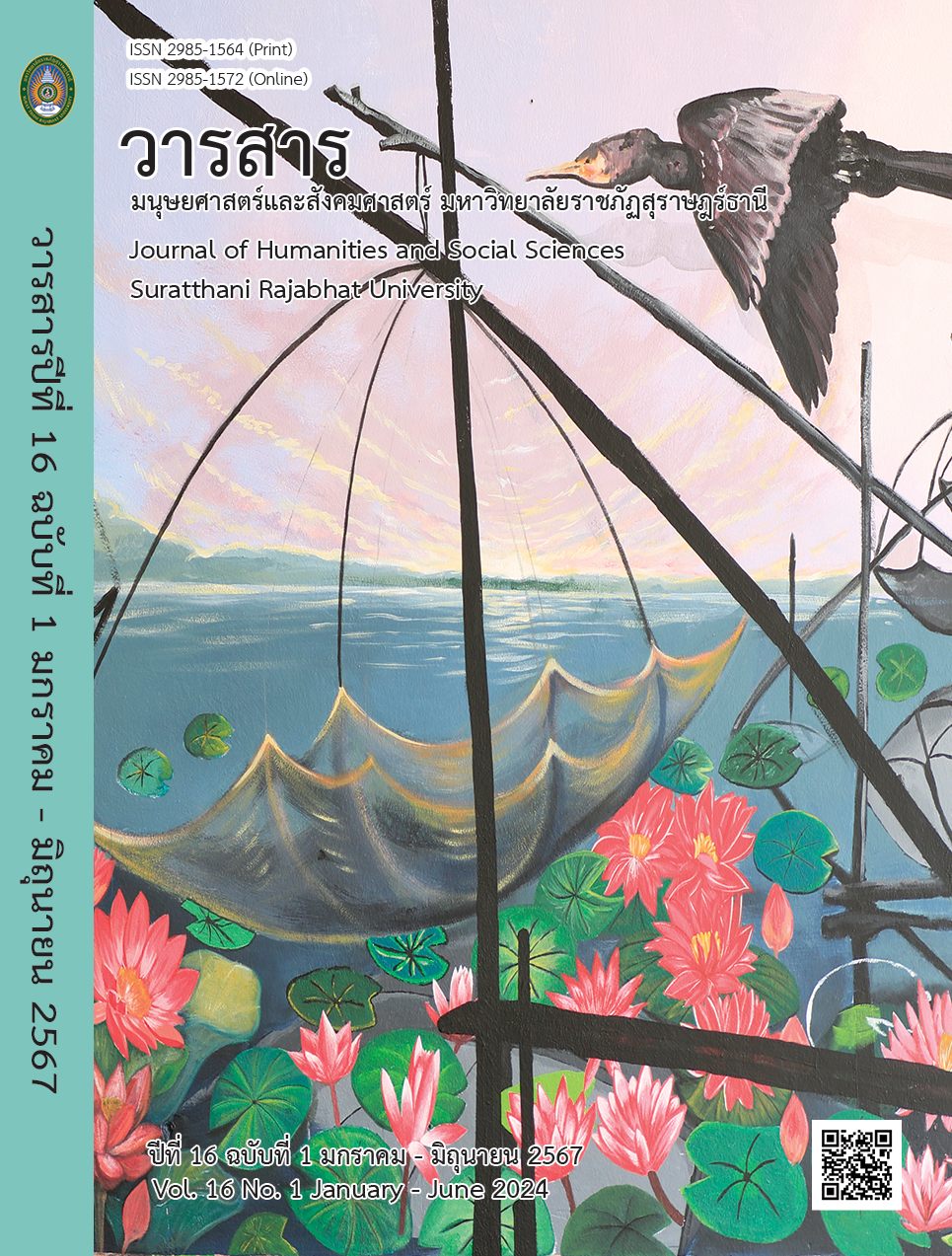Developing A Basic Guitar Skills Training Set For Junior High School Students, PBISS International School, Surat Thani
Main Article Content
Abstract
The objectives of this research were to 1) develop a basic guitar skill training package for lower secondary school students, PBISS International School in Surat Thani; 2) determine the efficiency of a basic guitar skill training package for lower secondary school students, PBISS International School in Surat Thani; and 3) compare the results of pre-and post-applications of
basic guitar skill training package for lower secondary school students, PBISS
International School in Surat Thani. Conducting studies with experimental
research (pre-experimental research). The sample for this study consisted of 20 grade 7 lower secondary school students, selected using simple random sampling using the classroom as a random unit by drawing lots. The instruments used in this research consisted of 1) a basic guitar skills training package; 2) a Lesson plan of a basic guitar skills training package; 3) a pre-and post-test. Determine the instrument is quality by evaluating the content is fidelity. By considering into consideration the index of consistency (Index of Item Objective Congruence: IOC) having a score of 0.75 on the IOC, Statistics used to
determine efficiency E1/E2 , and statistics used to evaluate data, Mean (x), Standard Deviation (S.D.), and comparing the findings. The T-test-dependent test of the hypothesis measures success in mastering basic guitar abilities.
The results of the research were as follows: 1) the development of a basic guitar skills training package comprised of 8 parts: 1.1) basic guitar; 1.2) the fretboard of a guitar; 1.3) basic music theory for guitar practice; 1.4) chords in key C and rhythm; 1.5) chords in key G and rhythm; 1.6) chords progression (I-vi-ii-V); 1.7) chords progression (IV-ii-V-I); and 1.8) examples of popular song, 2) the basic guitar skills training package scores the efficiency of 81.30/88.20 which met the specified 80/80 threshold, and 3) learning achievement through the basic guitar skill training package suggested that the mean of the post-test scores are higher than that of the pre-test scores with statistical significance (p=0.05). The results of the basic guitar skills
training package research provide guidelines for developing guitar playing skills. And teachers can use it to effectively create music instruction
management in other tools.
Article Details

This work is licensed under a Creative Commons Attribution-NonCommercial-NoDerivatives 4.0 International License.
All published manuscripts have been verified by peer-peer professors in the fields of humanities and social sciences. Reprinting of the article must be authorized by the editorial staff.
References
กมลธรรม เกื้อบุตร. (2554). กระบวนการสอนกีตาร์คลาสสิกของกีรตินันท์ สดประเสริฐ.
วารสารศิลปกรรมศาสตร์ มหาวิทยาลัยขอนแก่น, 3(1), 165-183.
ชานนท์ จงจินากูล. (2565). การพัฒนากิจกรรมการเรียนรู้ทักษะปฏิบัติกลองชุดตามแนว
คิดของเดวีส์ รายวิชาดุริยางค์สากล 2 สำหรับนักเรียนระดับประกาศนียบัตร
วิชาชีพชั้นปีที่ 1 วิทยาลัยนาฏศิลปกาฬสินธุ์. วิทยานิพนธ์ ดศ.ม. (ภาษาไทย).
มหาสารคาม: มหาวิทยาลัยมหาสารคาม.
ณรุทธ์ สุทธจิตต์. (2540). กิจกรรมดนตรีสำหรับครู (พิมพ์ครั้งที่ 3). กรุงเทพฯ: สำนักพิมพ์
แห่งจุฬาลงกรณ์มหาวิทยาลัย.
ณรุทธ์ สุทธจิตต์. (2541). จิตวิทยาการสอนดนตรี. กรุงเทพฯ: สำนักพิมพ์แห่งจุฬาลงกรณ์
มหาวิทยาลัย.
ณรุทธ์ สุทธจิตต์. (2561). ดนตรีศึกษา หลักการและสาระสำคัญ (พิมพ์ครั้งที่ 10).
กรุงเทพฯ: สำนักพิมพ์แห่งจุฬาลงกรณ์มหาวิทยาลัย.
ณัฐกร ชาคโรทัย, และ นัฏฐิกา สุนทรธนผล. (2560). การพัฒนาชุดการสอนกีตาร์เบื้องต้น
สำหรับนักเรียนชั้นมัธยมศึกษาปีที่ 1 โรงเรียนยอแซฟอุปถัมภ์ แผนกสามัญหญิง
อำเภอสามพราน จังหวัดนครปฐม. วารสารศิลปกรรมศาสตร์ มหาวิทยาลัย
ศรีนครินทรวิโรฒ, 21(2), 32-40.
ตติ แซ่แต่, พิมลมาศ พร้อมสุขกุล, ชาลินี สุริยนเปล่งแสง, และ วรสรณ์ เนตรทิพย์. (2564).
การสร้างชุดกิจกรรมการปฏิบัติกีตาร์ไฟฟ้าขั้นพื้นฐาน ชุมนุมดนตรีสากล
โรงเรียน วัดยานนาวาสำหรับนักเรียนชั้นประถมศึกษาตอนปลาย. วารสาร
ศิลปกรรมบูรพา, 24(1), 159-169.
บุญเกื้อ ควรหาเวช. (2542). นวัตกรรมการศึกษา (พิมพ์ครั้งที่ 4). กรุงเทพฯ: มหาวิทยาลัย
ศรีนครินทรวิโรฒ.
พงศธร ห้องแซง, และ คมกริช การินทร์. (2561). การพัฒนาชุดฝึกทักษะประกอบการเรียน
การสอนกีตาร์สำหรับนักเรียน ชั้นมัธยมศึกษาปีที่ 5. วารสารศึกษาศาสตร์
มหาวิทยาลัยมหาสารคาม, 12(2), 292-300.
วีระ ไทยพานิช. (2548). แบบฝึกเสริมทักษะ. กรุงเทพฯ: มหาวิทยาลัยสุโขทัยธรรมาธิราช.
สมนึก อุ่นแก้ว. (2563). ทฤษฎีดนตรีแนวปฏิบัติ (พิมพ์ครั้งที่ 10). อุดรธานี: ศักดิ์ศรีอักษร
การพิมพ์.
สันติ มุสิกา. (2565). การพัฒนาชุดฝึกทักษะการปฏิบัติกีตาร์เบื้องต้น (Guitar Basic)
ระดับชั้นมัธยมศึกษาปีที่ 4 โรงเรียนโพธิ์ไทรพิทยาคาร. วารสาร มจร. อุบล
ปริทรรศน์, 7(2), 2009-2022.
สิรวิชญ์ คิมหการ. (2551). เรียนลัดหัดเล่นกีตาร์ ด้วย Guitar Pro. กรุงเทพฯ: วิตตี้ กรุ๊ป.
อธิวัฒน์ พรหมจันทร์, และ อินทิรา รอบรู้. (2561). การพัฒนาชุดการเรียนการเล่นกีตาร์ขั้น
พื้นฐานสำหรับนักเรียนชั้นประถมศึกษาปีที่ 5 โรงเรียนเทพวิทยา. วารสารชุมชน
วิจัย, 12(3), 200-210.
อรรถวัตร ทิพยเลิศ. (2560). การพัฒนากิจกรรมการเรียนรู้เสริมสร้างทักษะการปฏิบัติ
กีตาร์ตามแนวคิดของเดวี่ส์ กลุ่มสาระการเรียนรู้ศิลปะ ชั้นมัธยมศึกษาปีที่ 4.
วิทยานิพนธ์ ค.ม. (ภาษาไทย). มหาสารคาม: มหาวิทยาลัยมหาสารคาม.
Bloom, B.S. (1964). Taxonomy of Education Objectives, Handbook 1: Cognitive
Domain. Boston: David Mekey.
Cambridge Assessment International Education. (2019). Cambridge Lower
Secondary Music Curriculum outline. Cambridge University. https://
www.cambridgeinternational.org/Images/554153-cambridge-lower-
secondary-curriculum-outline-music.pdf
Chapman, R. A. (1993). The Complete Guitar. London: Dorling Kindersley
Publishing Inc.
Davies, I.K. (1971). The Management of Learning. London: McGraw - Hill.
Fitz – Gibbon, C. T. & Morris, L. L. (1987). How to design a program evaluation.
London: Newbury Park.
Harrow, Anita J. (1972). A Taxonomy of the Psychomotor Domain: A Guide
for Developing Behavioral Objectives. New York: David McKay Co.
Piaget, J. (1936). Origins of intelligence in the child. London: Routledge &
Kegan Paul.


